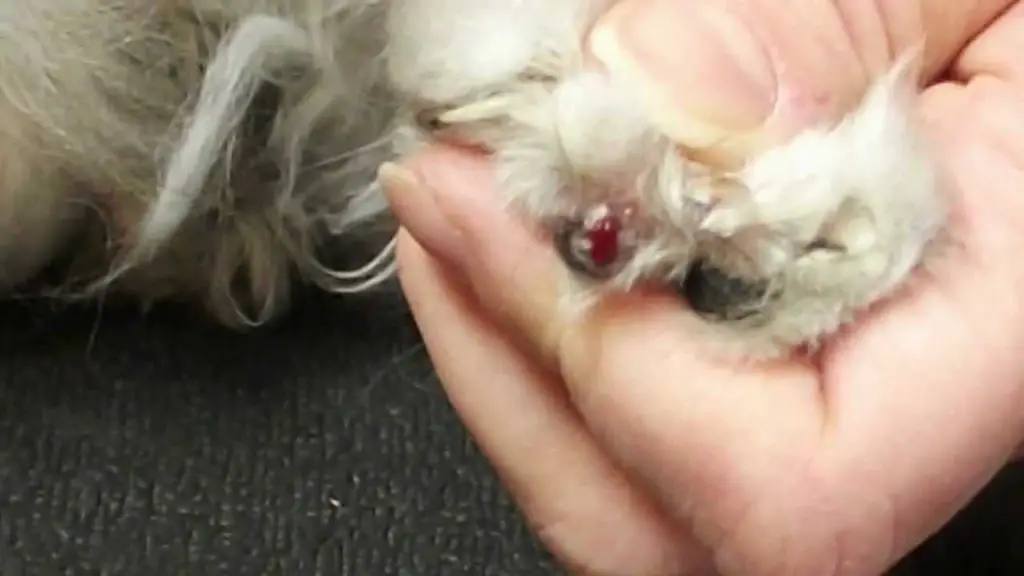Cat claw growing into the pad is a painful condition caused by the nail penetrating the soft tissue. Cat claw growing into the pad is a common problem that can cause a great deal of pain and discomfort for our feline friends.
This condition occurs when a cat’s nail starts to grow inwards, penetrating the soft pad tissue. It can happen due to various reasons, such as improper nail trimming, a broken or injured nail, or even a genetic predisposition. If left untreated, this can lead to infections, swelling, and even lameness.
So, it’s essential to monitor your cat’s nails regularly and provide them with proper nail care to prevent this issue. We will discuss the causes, symptoms, and treatment options for cat claw growing into the pad.
Causes Of Cat Claw Growing Into Pad
Cats have retractable claws that need regular maintenance. Incorrect grooming techniques can lead to a cat’s claw growing into the pad. Lack of regular nail trimming can contribute to this problem, as long nails are more prone to bending and growing inwards. Inadequate scratching options can also be a factor. Cats need to scratch on appropriate surfaces to shed the outer layers of their claws and keep them in good condition. Without proper scratching options, cats may resort to using furniture or other unsuitable surfaces, which can cause their claws to grow in an abnormal manner. It is essential to provide cats with scratching posts or boards to fulfill their natural scratching instincts. Regular nail trims and suitable scratching options are vital for preventing cat claw growth into the pad.

Credit: www.reddit.com
Signs And Symptoms
A cat claw growing into the pad can cause significant discomfort and pain for our feline friends. Recognizing the signs and symptoms early on is crucial in order to prevent further complications. One common sign to look out for is limping or favoring a certain leg, as the cat may be trying to relieve the pressure on the affected paw. Additionally, swelling and redness around the affected area can indicate a problem. Excessive licking or chewing of the paw may also be observed, as the cat tries to alleviate the discomfort.
Preventive Measures For Cat Claw Growing Into Pad
Cats have a natural instinct to scratch, and if their nails are not regularly trimmed, they can grow too long and curl into their pads. This can be a painful condition known as “cat claw growing into pad.” To prevent this from happening, it is important to take certain preventive measures.
Regular nail trimming is key to maintaining your cat’s paw health. Make sure to trim your cat’s nails every couple of weeks, or as needed. You can use a specialized cat nail trimmer to safely and effectively trim the nails.
Providing suitable scratching surfaces is another essential step. Cats scratch to remove the dead outer layer of their claws, and they need appropriate surfaces to do so. Offer your cat a variety of scratching posts and boards with different textures to cater to their preferences.
Training your cat on proper scratching behavior is crucial. Redirect their scratching behavior to the appropriate surfaces by encouraging them to use the scratching posts and gently discouraging them from scratching furniture or other inappropriate objects.
Choosing The Right Scratching Posts And Surfaces
Scratching posts and surfaces play a crucial role in preventing cat claw growing into pad. To ensure you choose the right scratching posts, it is important to consider the materials to avoid. Some materials to steer clear of include carpet, as it can mimic the texture of your cat’s nails. Likewise, bare wood should also be avoided, as it can cause splinters or be too hard for your cat’s claws. Opt for materials such as sisal rope or corrugated cardboard as they provide a satisfying texture for clawing and are less likely to cause any injury to your cat. These materials are also durable and can withstand constant scratching. Remember, by choosing the right scratching surfaces, you can ensure your cat’s claws remain healthy and prevent any potential pad injuries.
Proper Nail Trimming Techniques
Proper nail trimming is crucial for cats to prevent their claws from growing into the pad, which can lead to pain and discomfort. To ensure you trim your cat’s nails correctly and safely, you will need the following equipment:
| Equipment | Description |
|---|---|
| Nail clippers | Choose a pair of cat-specific nail clippers with a sharp cutting edge. |
| Styptic powder or gel | Apply a small amount of styptic powder or gel to quickly stop bleeding in case of an accidental cut. |
| Treats or rewards | Reward your cat throughout the trimming process to create a positive association. |
| Towel or blanket | Place a towel or blanket on your lap or a stable surface to provide comfort and security for your cat. |
| Scratching post or mat | Encourage your cat to use a scratching post or mat to help naturally wear down their claws. |
Follow these step-by-step instructions to trim your cat’s nails:
- Gently hold your cat’s paw and press the pad to extend the claws.
- Identify the translucent area called the “quick” within the claw.
- Position the nail clippers and cut just the pointed tip of the claw, avoiding the quick.
- Offer a treat or reward to reinforce positive behavior.
- Repeat the process for each claw, gradually increasing the number over time until all claws are trimmed.
- If accidentally cut into the quick, apply styptic powder or gel to stop any bleeding.
Regular and proper nail trimming should be done to help prevent cat claw overgrowth and potential paw pad issues. Remember to be patient, gentle, and use the right tools for a stress-free experience for both you and your cat.
Treatment Options For Cat Claw Growing Into Pad
| Treatment Options for Cat Claw Growing into Pad |
|---|
| Veterinary examination and diagnosis |
| Sedation and proper clipping of the embedded claw |
| Post-treatment care and monitoring |
Cat Claw Growing into Pad is a common issue among cats that can cause discomfort and potential complications if not addressed promptly. Veterinary examination and diagnosis are essential to evaluate the extent of the problem. Once identified, the embedded claw may require sedation to ensure a safe and stress-free trimming procedure. By carefully clipping the ingrown claw, veterinarians can alleviate the pain and prevent further damage. Post-treatment care is crucial to promote healing and prevent infections. Keeping the wound clean and providing pain relief if necessary are key elements of the recovery process. Regular monitoring is important to detect any signs of recurrence or complications. It is crucial for cat owners to seek professional veterinary assistance when dealing with a cat claw growing into the pad to ensure the best outcome for their feline companions.
Conclusion
It is crucial to regularly inspect and trim your cat’s claws to prevent them from growing into the pads. By providing proper nail care, you can avoid discomfort and potential infections for your furry friend. Remember to be gentle and patient during this grooming process, and always consult a veterinarian if you notice any abnormalities.
Keep your feline companion happy and healthy with proper claw maintenance!


